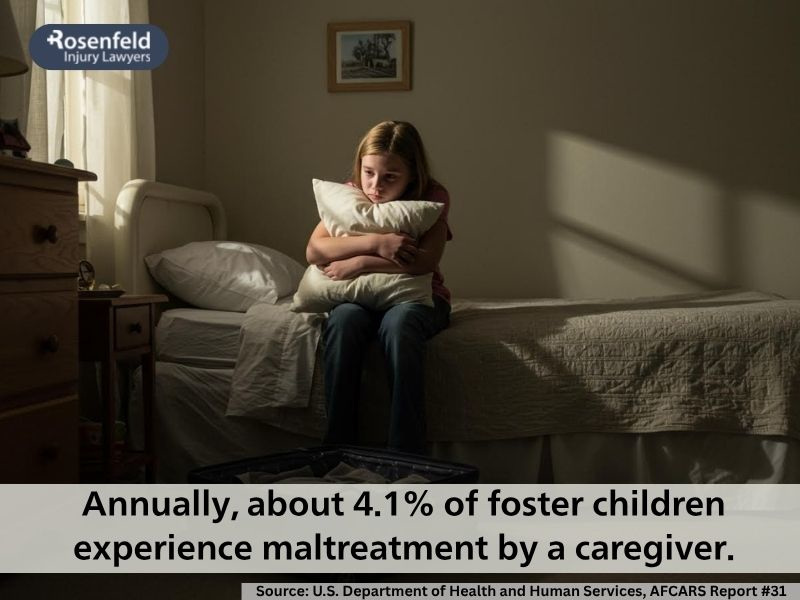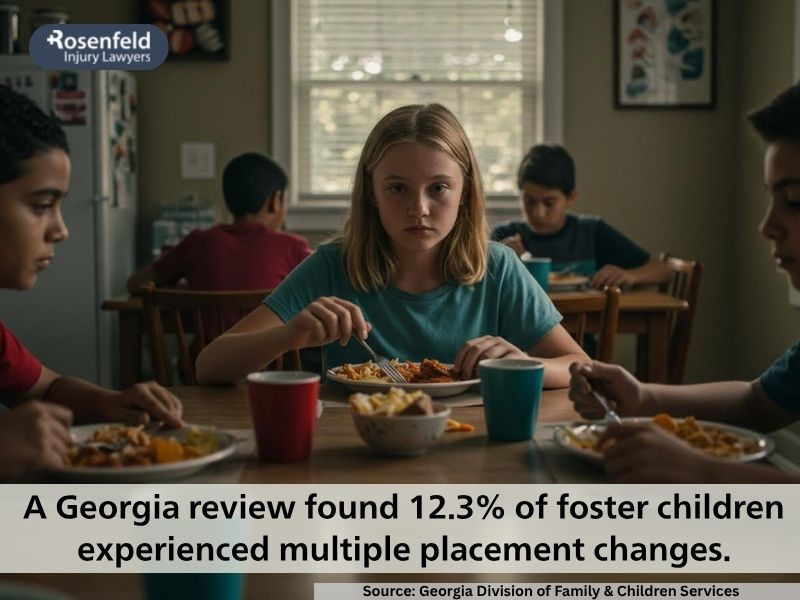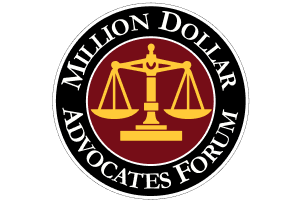What Constitutes Foster Care Abuse?
Foster care abuse refers to any form of mistreatment, neglect, or harm inflicted on children in foster care by parents, caregivers, or others responsible for their well-being. While foster care is meant to protect children removed from unsafe home environments, abuse within the child welfare system remains a serious concern affecting many children nationwide.
At Injury Lawyer Team, we help victims of abuse seek accountability and financial compensation. Our experienced foster care abuse attorneys have supported families and children across the country, standing up to negligent foster care agencies, group homes, and human services departments.

What Are the Types of Child Maltreatment and Abuse in Foster Care?
In the United States, 176,340 children are currently in foster care, with a rate of 2.4 per 1,000 children in the general population. Many children entering foster care continue to experience harm in the very systems meant to protect them.
Neglect
Neglect is the most commonly reported form of maltreatment in foster care. It occurs when foster parents or caregivers fail to provide a child with the necessities of life, including:
- Physical neglect: Failing to provide adequate food, shelter, or medical care. Many children living in foster homes report being left hungry, wearing dirty clothes, or going without proper medical care.
- Emotional neglect: Ignoring a child’s need for love, comfort, or attention. Children may be isolated, shamed, or denied affection, which can lead to long-term emotional harm.
- Educational neglect: Preventing a child from attending school or failing to support their learning needs. These vulnerable children already face disruptions in their education, and neglect only makes it harder for them to succeed academically.
Neglect is often harder to detect than physical abuse, but its impact can be just as damaging–leading to depression, low self-esteem, and severe physical health problems.
Physical Abuse
Physical abuse involves any intentional act that causes injury or physical pain to a child. In the foster system, this may include:
- Hitting or slapping
- Burning or scalding
- Shaking
- Restraining in harmful ways
- Forcing a child into physically punishing positions
Foster children who are physically abused often suffer in silence, especially if they fear retaliation or don’t have a trusted adult to report the abuse to. Repeated injuries, unexplained bruises, or a child’s fear of going home can be signs of physical abuse in a foster home or group setting.
Sexual Abuse
Sexual abuse in foster care includes any sexual contact or behavior with a child, including:
- Inappropriate touching
- Exposure to pornography
- Sexual assault or rape
- Sexual exploitation by foster parents, other children in the home, or staff in group homes
Many children in foster care are more likely to be abused due to being placed in homes with known risks or with parents who were not properly screened by child welfare agencies or the Department of Health and Human Services.
Sexual abuse can cause lifelong trauma and severe emotional distress. Survivors often struggle with trust, identity, and relationships well into adulthood.
Psychological Abuse
Psychological or emotional abuse is harder to spot but deeply harmful. It involves behaviors that make a child feel unwanted, unloved, or worthless. Examples include:
- Constant criticism or humiliation
- Threats or intimidation
- Isolation from friends or family
- Blaming the child for problems in the home
Youth in foster care who experience emotional abuse often face long-term issues like anxiety, PTSD, and depression. Psychological abuse can be especially damaging for children already dealing with past trauma, family separations, or instability in the foster care system.

What Are the Children’s Bureau Statistics of Foster Care Abuse and Neglect?
The Children’s Bureau develops the annual Child Maltreatment reports.
In 2023, there were 4,399,000 referrals to child protective services (CPS) involving 7,782,000 children. From those referrals, 47.5% were screened in for investigation, becoming formal reports, and 52.5% were closed without further action.
Of the reports that were screened in, 2,107,473 reports received a formal disposition or outcome. These reports involved 3,081,715 children, 546,159 of whom were confirmed victims of abuse or neglect.
What Is the Demographic Profile of Children Entering Foster Care?
Children Entering Foster Care by Age Group:
- Under 1 year: 19%
- 1 to 5 years: 28%
- 6 to 10 years: 20%
- 11 to 15 years: 22%
- 16 to 20 years: 10%
Rate of Entry (per 1,000 children in each age group):
- Under 1 year: 9.4 per 1,000
- 1 to 5 years: 2.7
- 6 to 10 years: 1.8
- 11 to 15 years: 0.8
- 16 to 20 years: 1.9
Children in Foster Care by Gender:
- Male children: 183,088 (51%)
- Female children: 177,441 (49%)
Percentage of Children Entering Foster Care by Race and Ethnicity:
- Non-Hispanic White: 44%
- Non-Hispanic Black: 22%
- Hispanic or Latino: 21%
- Non-Hispanic multiple races: 8%
- Non-Hispanic American Indian: 2%
- Non-Hispanic Asian or Native Hawaiian: 1%
By comparison, the general U.S. child population is:
- Non-Hispanic White: 48%
- Non-Hispanic Black: 14%
- Hispanic or Latino: 27%
- Non-Hispanic multiple races: 5%
- Non-Hispanic American Indian: 1%
- Non-Hispanic Asian/Native Hawaiian: 6%
Where Are Children in Foster Care Typically Placed?
The most common type of placement is a foster family home with non-relatives, which accounted for 43% of all placements. The second most common placement is with relatives, such as grandparents, aunts, or extended family members, making up 31% of all cases.
About 11% of children were placed in foster homes or institutions, which often serve older youth or those with higher medical or behavioral needs. Other placement types include pre-adoptive homes (6%), trial home visits (4%), and supervised independent living programs for older teens (3%).
A small percentage of children, around 2%, are classified as runaways–a group that often includes youth who fled from unsafe or unstable foster homes.
39% of foster children had more than two placements, meaning they moved from one home or facility to another multiple times.

What Are the Statistics of Children Exiting Foster Care?
In 2023, 188,290 children exited foster care in the United States due to the following reasons:
- Reunification with parent or primary caretaker: 45% of all exits (most common outcome)
- Adoption: 27% of exits
- Guardianship (long-term care by a relative or non-relative without adoption): 11%
- Living with other relatives (informal or court-approved placements): 7%
- Emancipation (aging out at 18 or 21 without permanency): 8%
- Transfer to another agency: 1%
- Runaway: Less than 0.5%
- Death: Less than 0.5%
As of 2023, more than 113,000 children were still waiting for adoption. Among them, the length of time spent waitingis as follows:
- 26% waited 12 to 23 months
- 25% waited 24 to 35 months
- 25% waited 3 to 4 years
- 15% waited 5 years or more
How Common Is Foster Care Abuse?
In 2023, 3,058,291 children in the United States were the subject of a report that was investigated by child protective services. Of those, 542,904 were confirmed victims of maltreatment, meaning they experienced child abuse or neglect that met the standards for a substantiated finding, translating to a national rate of 7 victims per 1,000 children.
Types of Maltreatment Among Confirmed Victims:
- Neglect: 401,829 children (74%)
- Physical abuse: 94,599 children (17%)
- Sexual abuse: 53,547 children (10%)
- Emotional abuse: 37,748 children (7%)
- Medical neglect: 10,993 children (2%)
Confirmed Victims by Age Group:
- Ages 0–4: 38%
- Ages 5–10: 31%
- Ages 11–13: 14%
- Ages 14–17: 16%
Gender Distribution Among Confirmed Victims:
- Female: 52%
- Male: 48%
Out of the total number of confirmed victims in 2023, only about 51% (276,020 children) received services after the abuse was substantiated. That means nearly half of the children identified by the system as maltreatment victims did not receive any follow-up support, even though many were likely placed in foster or other types of out-of-home care.
What Challenges Do Children in Foster Care Face After Child Abuse and Neglect?
Children who experience abuse or neglect and then enter the foster care system often face significant obstacles, both while in care and as they transition into adulthood. Many of these challenges stem directly from the trauma of their past experiences and the instability of foster placements, and national statistics show that these youth continue to struggle long after they leave care.
By age 17, 24% of foster youth reported having experienced homelessness, highlighting how difficult it is for many to secure safe and stable housing.
Entering the criminal justice system is another pressing concern. At age 17, 26% of youth in foster care are incarceratedat some point.
Educational outcomes also reveal deep disparities. At age 17, 92% of foster youth had not yet earned a high school diploma or GED, and only a small percentage pursued further education as they aged. By age 21, only 2% had earned an associate degree, and just 3% had completed a vocational certificate.
Employment statistics are similarly concerning. At age 17, only 20% of foster youth were employed, either part-time or full-time. While employment rates do improve slightly with age—59% were employed by age 21—that still leaves over 40% of young adults aging out of foster care unemployed and likely struggling to meet basic needs without adequate support systems.
In addition, some foster youth face the added burden of early parenthood. By age 17, 5% of youth in foster care had already had a child, introducing significant emotional and financial pressures at a young age, often without a stable home, steady income, or reliable family network to support them.
What Laws Govern the Foster Care Child Welfare System?
The following laws shape the rights of children in foster homes:
42 U.S.C. § 671(a)(19) requires that reasonable efforts be made to place foster children with relatives when safe and appropriate. This approach helps children maintain connections to their culture, family, and community.
Under 42 U.S.C. § 671(a)(31), siblings placed in foster care should be kept together in the same foster home, unless it is not in their best interests. Separation from siblings can deepen trauma and lead to emotional instability.
42 U.S.C. § 675(5)(A) mandates that children be placed in the least restrictive, most family-like setting appropriate to their needs–and as close as possible to their parents’ home. This approach reduces disruption and supports potential reunification.
Under 42 U.S.C. § 675(1)(G)(i), to promote educational continuity, children in foster care should remain in their original school whenever feasible to help reduce academic setbacks and social disruption.
Enacted in 2018, the Family First Prevention Services Act (FFPSA) shifts the focus of child welfare from reacting to family crises to preventing them. The law allows federal funds to be used for evidence-based services that help support families and prevent children from entering foster care. It also limits federal funding for placements in institutional settings, unless the child’s needs require it.

What Legal Options Do Children and Families in Foster Care Have?
Victims of foster care abuse and neglect can file civil lawsuits against social workers, child welfare agencies, and even the state’s department of health and human services if there was negligence or failure to protect vulnerable children. Common types of damages that may be recovered in foster care abuse cases include:
- Medical Expenses: Reimbursement for current and future treatment, including therapy, hospital bills, medications, and specialized care for physical health issues or trauma.
- Pain and Suffering: Compensation for emotional distress, anxiety, PTSD, depression, and the impact of psychological abuse or sexual abuse.
- Loss of Quality of Life: Damages related to the long-term effects of child maltreatment, including barriers to education, employment, and relationships.
- Punitive Damages: In extreme cases, courts may award punitive damages to punish gross negligence or willful misconduct and deter similar abuse in the future.
- Loss of Educational Opportunities: If neglect, placement disruptions, or trauma led to academic setbacks, victims may be entitled to damages for those losses.
- Housing Support or Transitional Care: For youth aging out of foster care who were harmed and left without access to basic needs or stable families, damages can help support independent living.
Every state has its own laws on how long a victim has to file a personal injury lawsuit, known as the statute of limitations. However, when it comes to child abuse and neglect, the statute of limitations for personal injury claims is tolled until the victim turns 18. This means children can usually bring a claim after they become adults, often within 2–6 years of reaching legal age.
Recognizing the long-lasting trauma of sexually abused children, more states are removing the statute of limitations for civil sexual abuse claims entirely. This shift is supported by growing national awareness and advocacy, particularly for those harmed while in out-of-home care.
How Injury Lawyer Team Can Help
At Injury Lawyer Team, we represent children harmed by abuse or neglect in foster care. Our sexual abuse lawyer teamunderstands the deep emotional and legal challenges these cases bring. We’re committed to helping victims pursue justice and financial recovery for the harm caused by failures in the child welfare system.
We offer free, confidential consultations to help you understand your rights and legal options. Our attorneys work on a contingency basis, meaning you don’t pay unless we win compensation for you.
If you know of a child harmed in foster care, we’re here to protect their rights and fight for their future.
All content undergoes thorough legal review by experienced attorneys, including Jonathan Rosenfeld. With 25 years of experience in personal injury law and over 100 years of combined legal expertise within our team, we ensure that every article is legally accurate, compliant, and reflects current legal standards.








